Did anyone else watch the American Baking Competition earlier this summer?
I was addicted to it (so bummed there won’t be a second season!). I loved the setup: bake a “signature” item, demonstrate technical expertise, bake something fancy and complicated. It really got me thinking…do I have a signature pie or a signature bread? I don’t really think so.
In one of the early weeks, the “showstopper” challenge was French macarons. I felt some sympathy for the poor bakers as they received criticism from the judges about consistency and texture. Until recently, I had never been able to make a proper macaron, not like those I sampled in Paris two years ago. Mine always came out a little flat, with frilly edges, and still quite gooey inside. I couldn’t understand it! I followed the famed Tartelette recipe to a T! I read tips and tutorials…I tried aging the egg whites vs. using fresh; using commercially ground almond meal vs. grinding my own; using Silpat vs. parchment; drying the shells longer; folding more vigorously; changing the oven temp…honestly, I was stumped.
Macarons can be so frustrating!
But then…I met the Italian meringue method. And for the first time ever, beautiful, properly baked macarons emerged from my oven! It was a miracle!
Be brave. Be friends with your candy thermometer. Make macarons the Italian way!
Okay, I am serious. You must have a candy thermometer and a digital food scale to make these. Macarons are not for the faint of heart.
The key here is being very exact. If you are the kind of baker who likes to use approximations, you may need to steel yourself for a lot of back and forth here: adding a little more water, then pouring a little more out; spooning in a bit of almond meal, then pinching some back out. Exact gram measurements are critical!
But once you commit yourself to being precise, these macarons aren’t so bad! You can make an afternoon of it.
Start out by measuring the egg whites. You need 90 grams in a large mixing bowl to turn into a soft meringue, and 82 grams in a measuring cup to mix into the almond meal mixture. I used egg whites that had been aged for 4 days, which isn’t strictly necessary when making Italian meringue-style macarons, but it made me feel safer anyway. Aged egg whites have a lower moisture content, which allows them to whip up better.
Set the egg whites out to come to room temperature.
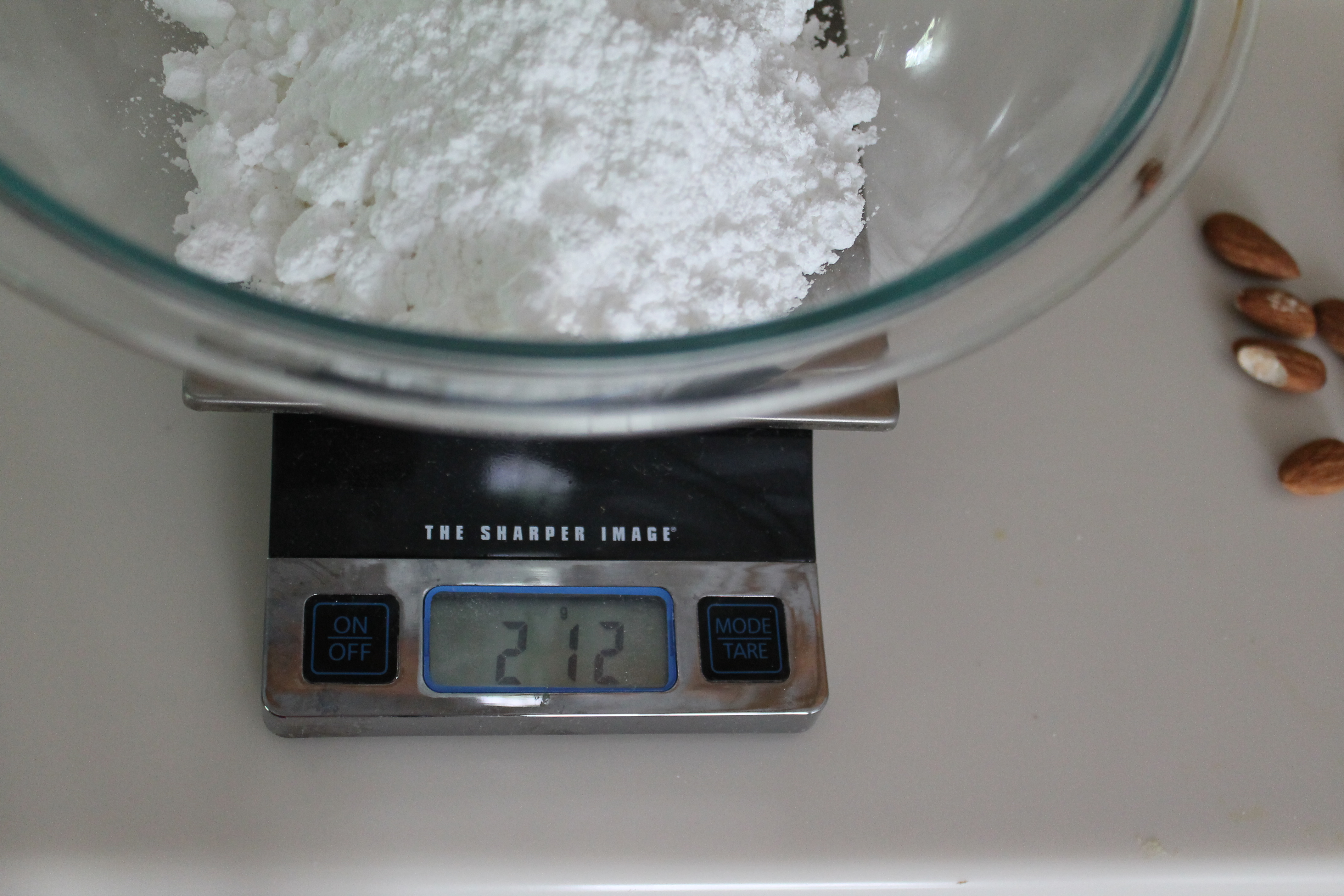 Meanwhile, you can measure the rest of your ingredients. Drop a pinch of granulated sugar into the mixing bowl with the 90 grams of egg whites. Combine the water and granulated sugar in a small, heavy-bottomed saucepan. Stir together the almond meal and confectioner’s sugar. You can grind up your own almond meal (I recommend processing the nuts and the confectioner’s sugar together to cut down on the oiliness of the freshly pulverized nuts), but of course it is much easier to use commercially ground almonds.
Meanwhile, you can measure the rest of your ingredients. Drop a pinch of granulated sugar into the mixing bowl with the 90 grams of egg whites. Combine the water and granulated sugar in a small, heavy-bottomed saucepan. Stir together the almond meal and confectioner’s sugar. You can grind up your own almond meal (I recommend processing the nuts and the confectioner’s sugar together to cut down on the oiliness of the freshly pulverized nuts), but of course it is much easier to use commercially ground almonds.
And now is a great time to go ahead and draw your piping patterns! You don’t absolutely have to do this, but it’s a really good idea if you aren’t amazing at piping identically-sized circles freehand. I used the top of a vitamin bottle, which was about 2″ in diameter, and traced it at about 1½″ intervals on 4 sheets of parchment paper.
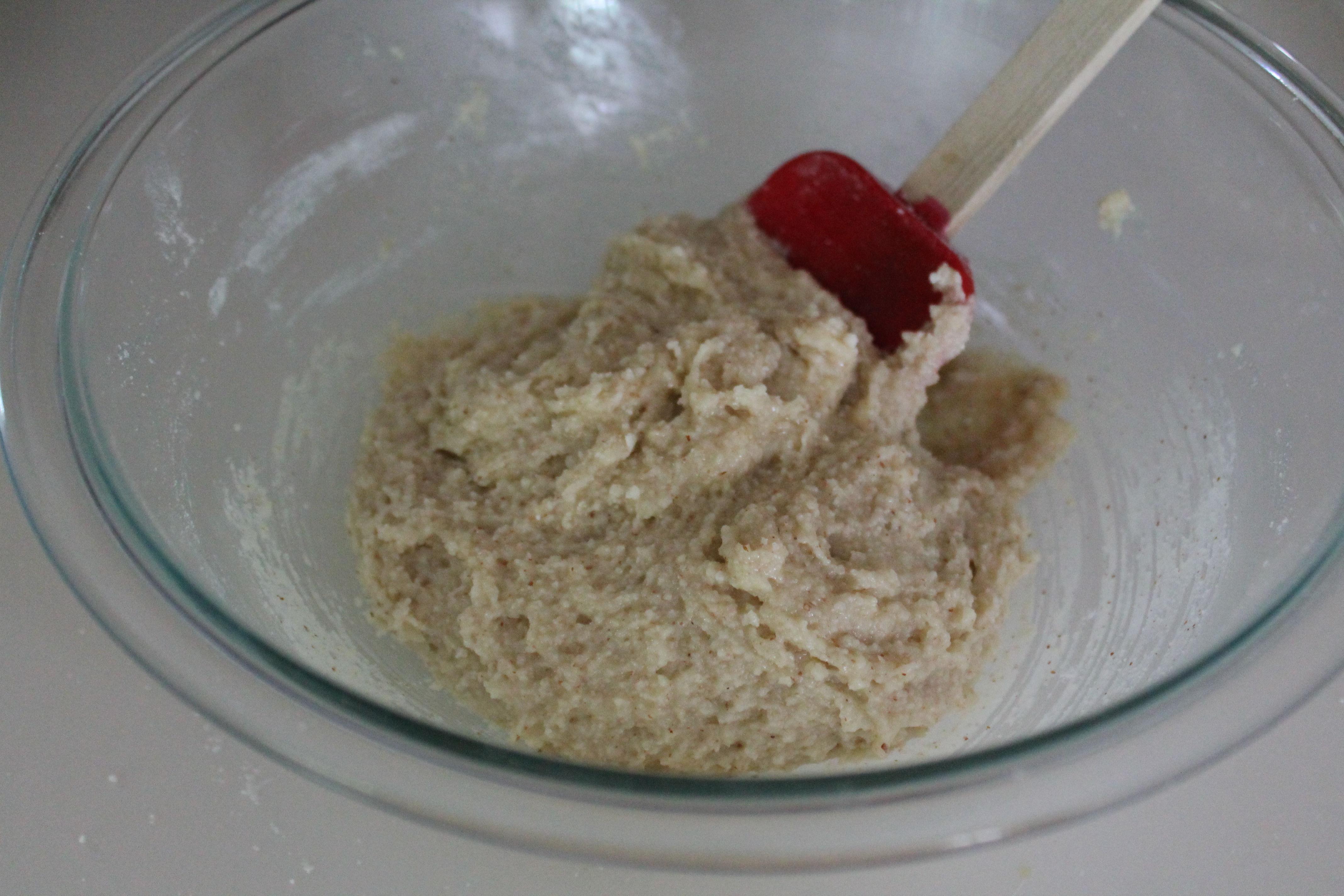 When the egg whites have come to room temperature, it’s go time! Stir the 82 grams of egg whites into the almond meal–sugar mixture. It should form a thick almondy paste. Set it aside.
When the egg whites have come to room temperature, it’s go time! Stir the 82 grams of egg whites into the almond meal–sugar mixture. It should form a thick almondy paste. Set it aside.
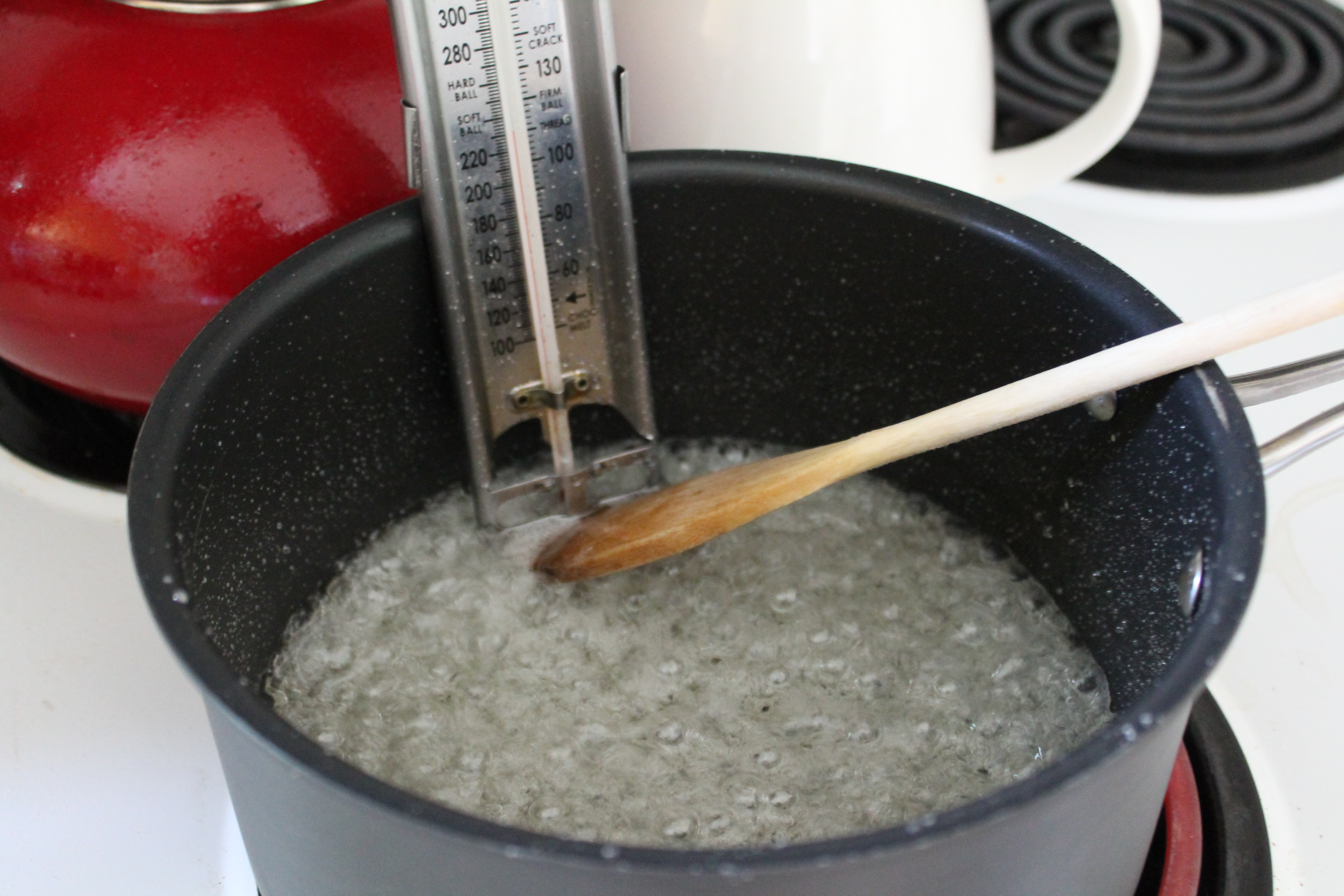 Now grab your candy thermometer. Don’t even think about trying to use a meat thermometer, or trying to wing it without a thermometer at all. If you miss the right temperature (firm ball stage on the candy thermometer), your meringue will deflate and you will end up with watery cooked egg whites when you try to beat in the sugar syrup.
Now grab your candy thermometer. Don’t even think about trying to use a meat thermometer, or trying to wing it without a thermometer at all. If you miss the right temperature (firm ball stage on the candy thermometer), your meringue will deflate and you will end up with watery cooked egg whites when you try to beat in the sugar syrup.
Bring the sugar to a boil over medium heat, keeping a careful eye on the candy thermometer.
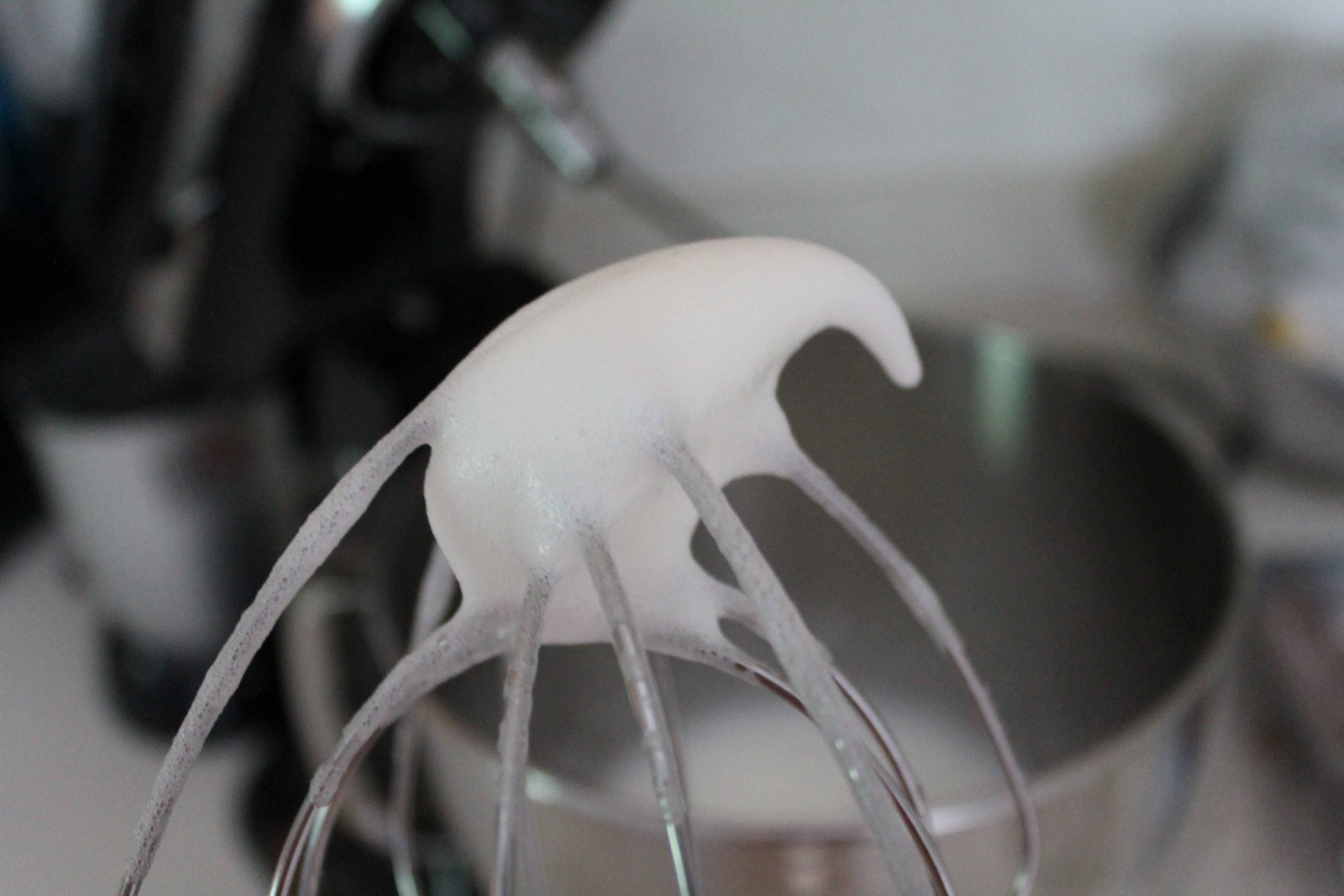 When the temperature on the sugar reaches 200°, go ahead and start the 90 grams of egg whites whipping. When they form soft peaks, turn the mixer down to the slowest speed to keep them moving until the sugar syrup is ready.
When the temperature on the sugar reaches 200°, go ahead and start the 90 grams of egg whites whipping. When they form soft peaks, turn the mixer down to the slowest speed to keep them moving until the sugar syrup is ready.
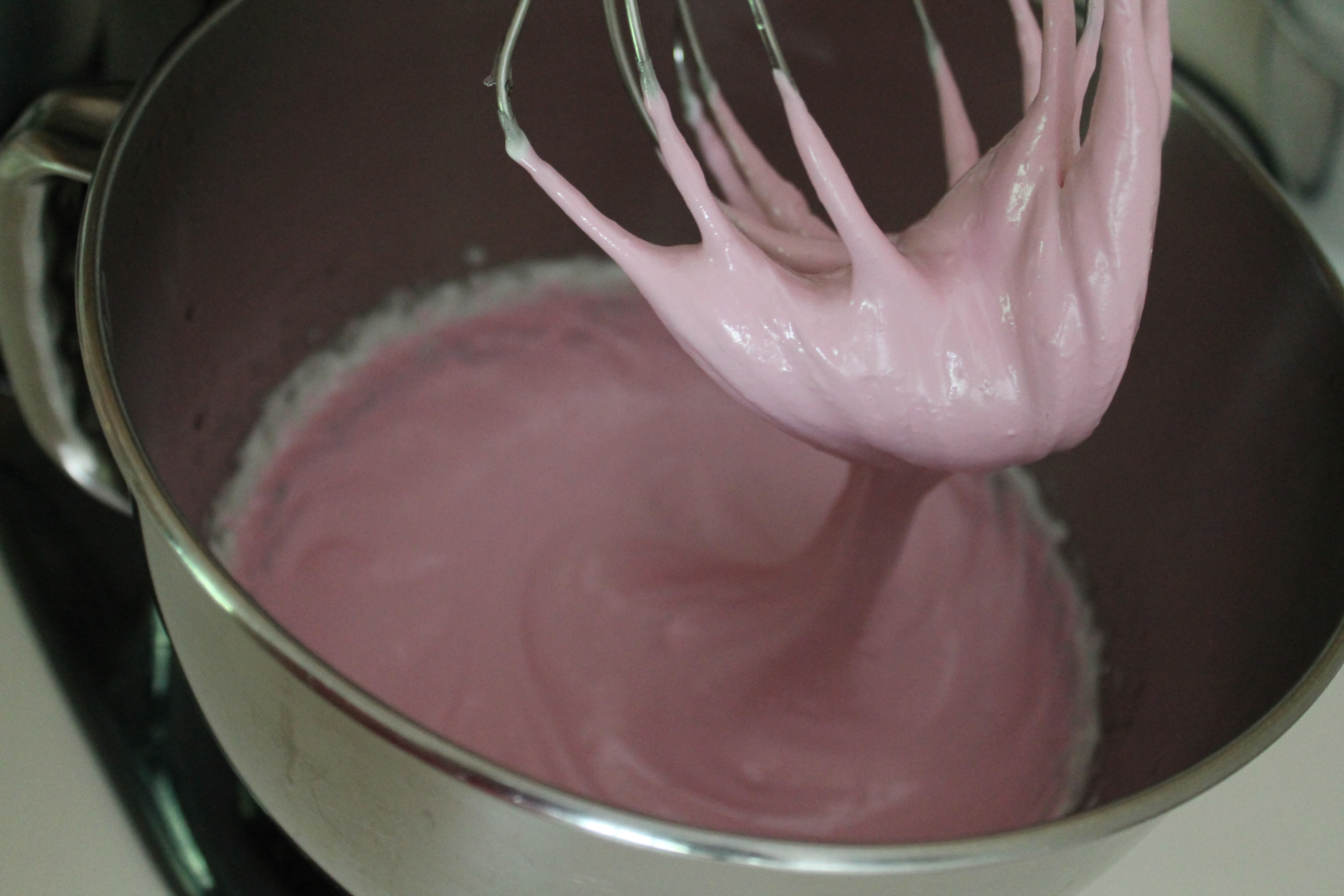 The very instant the candy thermometer reaches 248°, or firm ball stage, remove it from the heat. Increase the mixer speed to medium and very slowly drizzle the hot sugar into the meringue. It should become glossy and brightly white.
The very instant the candy thermometer reaches 248°, or firm ball stage, remove it from the heat. Increase the mixer speed to medium and very slowly drizzle the hot sugar into the meringue. It should become glossy and brightly white.
When all the sugar has been mixed in, increase the mixer speed to high and whip until the meringue forms very stiff, glossy peaks. By this point, it should be warm but not hot to the touch. If you want to dye your shells, add in your food coloring gel or powder now!
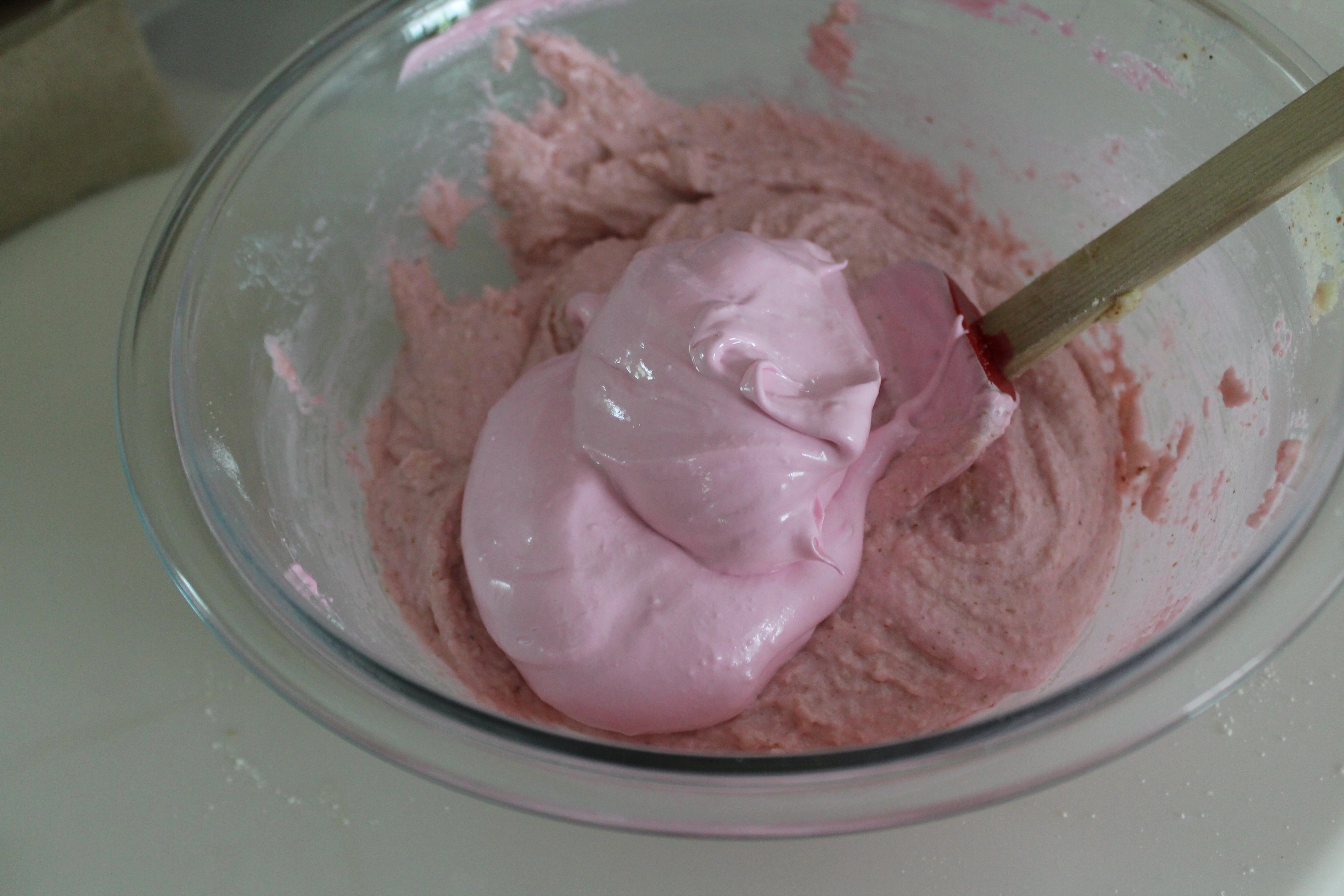 Fold about one third of the meringue into the almond paste mixture. When the mixture becomes smooth and even, begin adding in the rest of the meringue, a bit at a time, until the batter reaches proper piping consistency. It should be thick and not soupy, but should slowly reabsorb the lumps on top if you drizzle a ribbon of batter off the end of your spatula.
Fold about one third of the meringue into the almond paste mixture. When the mixture becomes smooth and even, begin adding in the rest of the meringue, a bit at a time, until the batter reaches proper piping consistency. It should be thick and not soupy, but should slowly reabsorb the lumps on top if you drizzle a ribbon of batter off the end of your spatula.
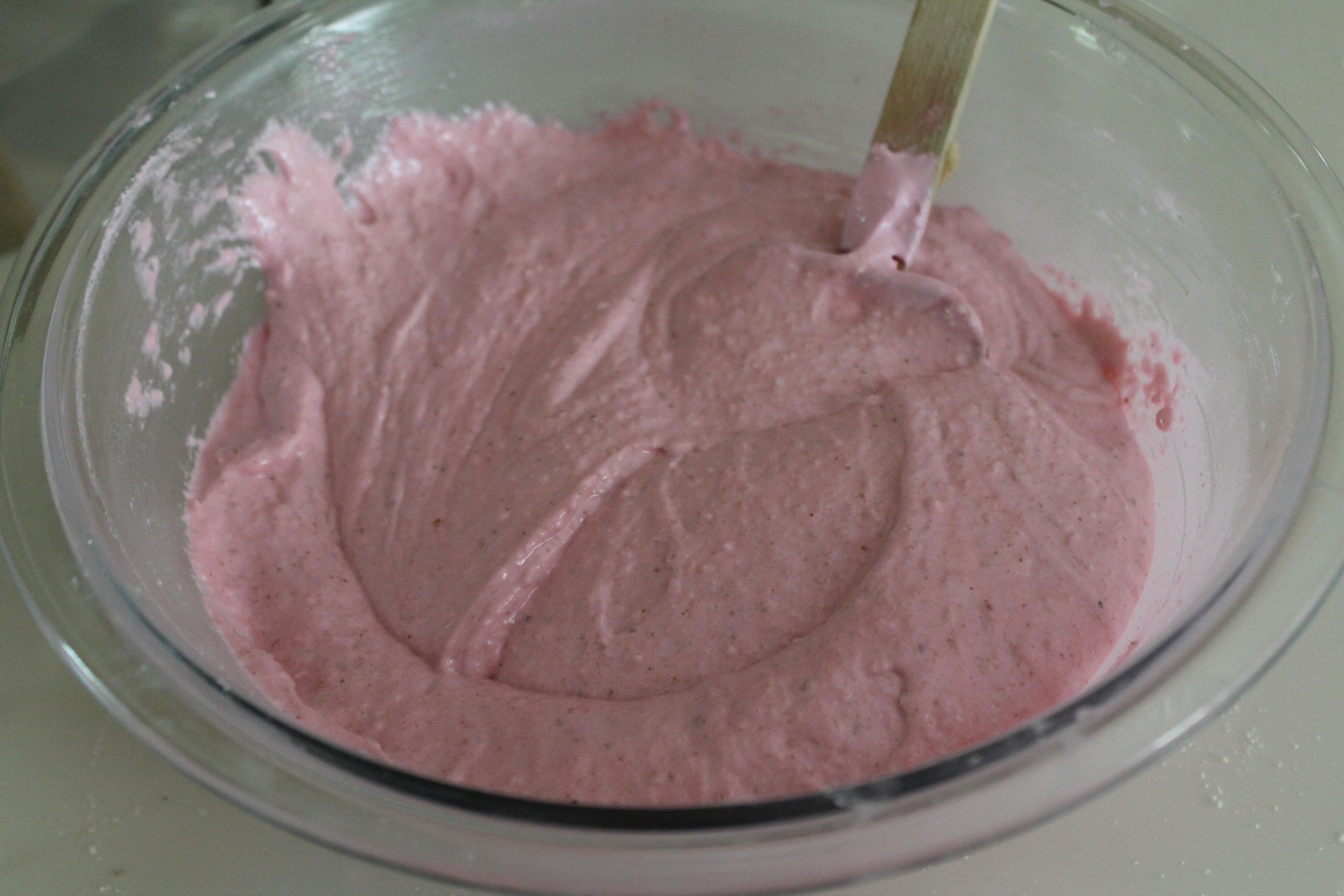 Spoon the macaron batter into a piping bag fitted with a large round tip. Lay the prepared sheets of parchment onto 4 cookie sheets (don’t forget to place the written-on sides down! the cookies will absorb the pen or marker otherwise). If you don’t have 4 cookie sheets, set the extras out on thin cutting boards; you should go ahead and pipe all the shells now and then gently slide the extra sheets of parchment onto the cookie sheets when they become free.
Spoon the macaron batter into a piping bag fitted with a large round tip. Lay the prepared sheets of parchment onto 4 cookie sheets (don’t forget to place the written-on sides down! the cookies will absorb the pen or marker otherwise). If you don’t have 4 cookie sheets, set the extras out on thin cutting boards; you should go ahead and pipe all the shells now and then gently slide the extra sheets of parchment onto the cookie sheets when they become free.
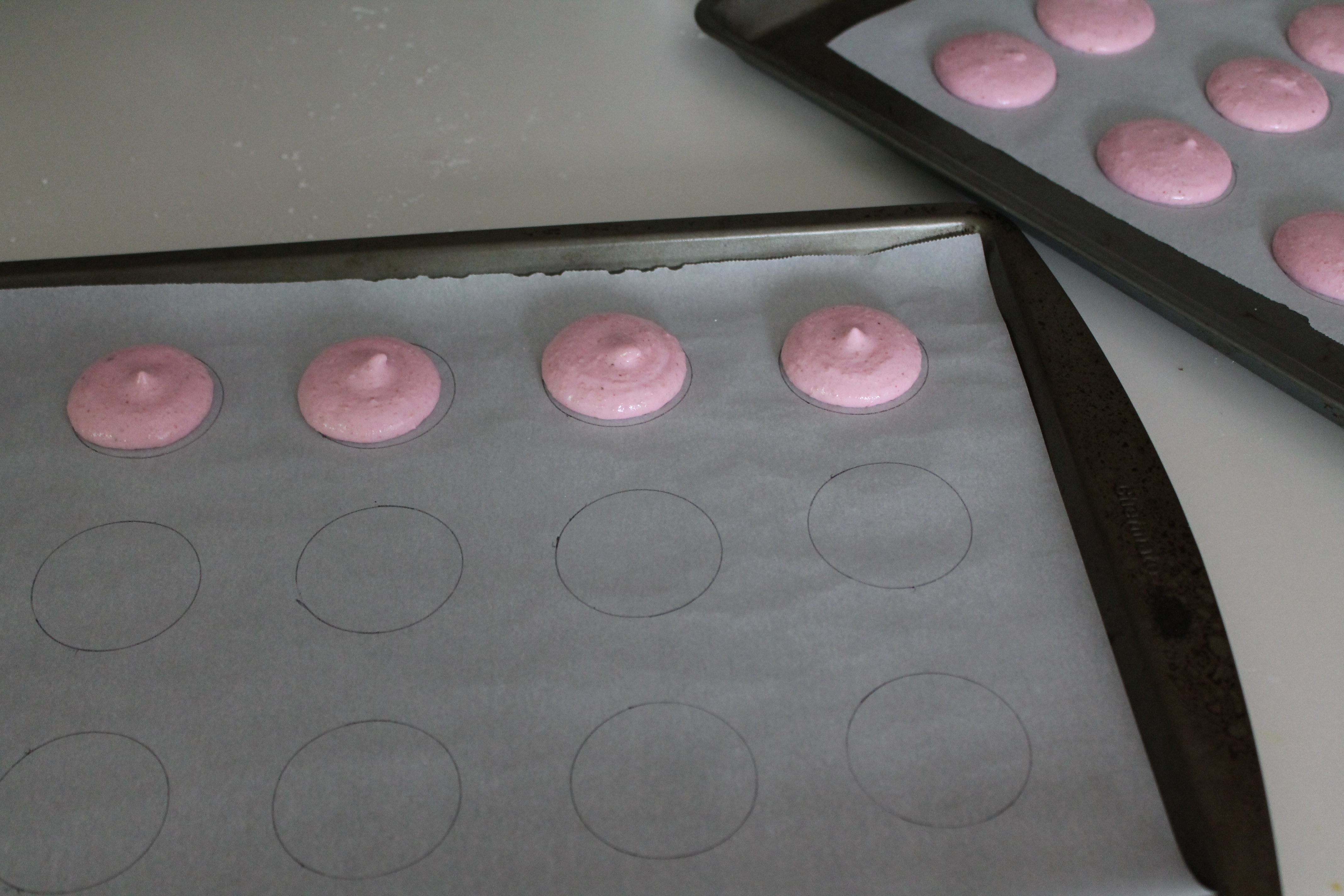 Pipe the batter into the drawn circles. Drop the cookie sheets several times onto the counter to release any latent air bubbles.
Pipe the batter into the drawn circles. Drop the cookie sheets several times onto the counter to release any latent air bubbles.
Bake at 325° for 10–14 minutes, checking every minute or so after 9 minutes. When the macarons are done, you should be able to easily pull one off the macarons off of the paper.
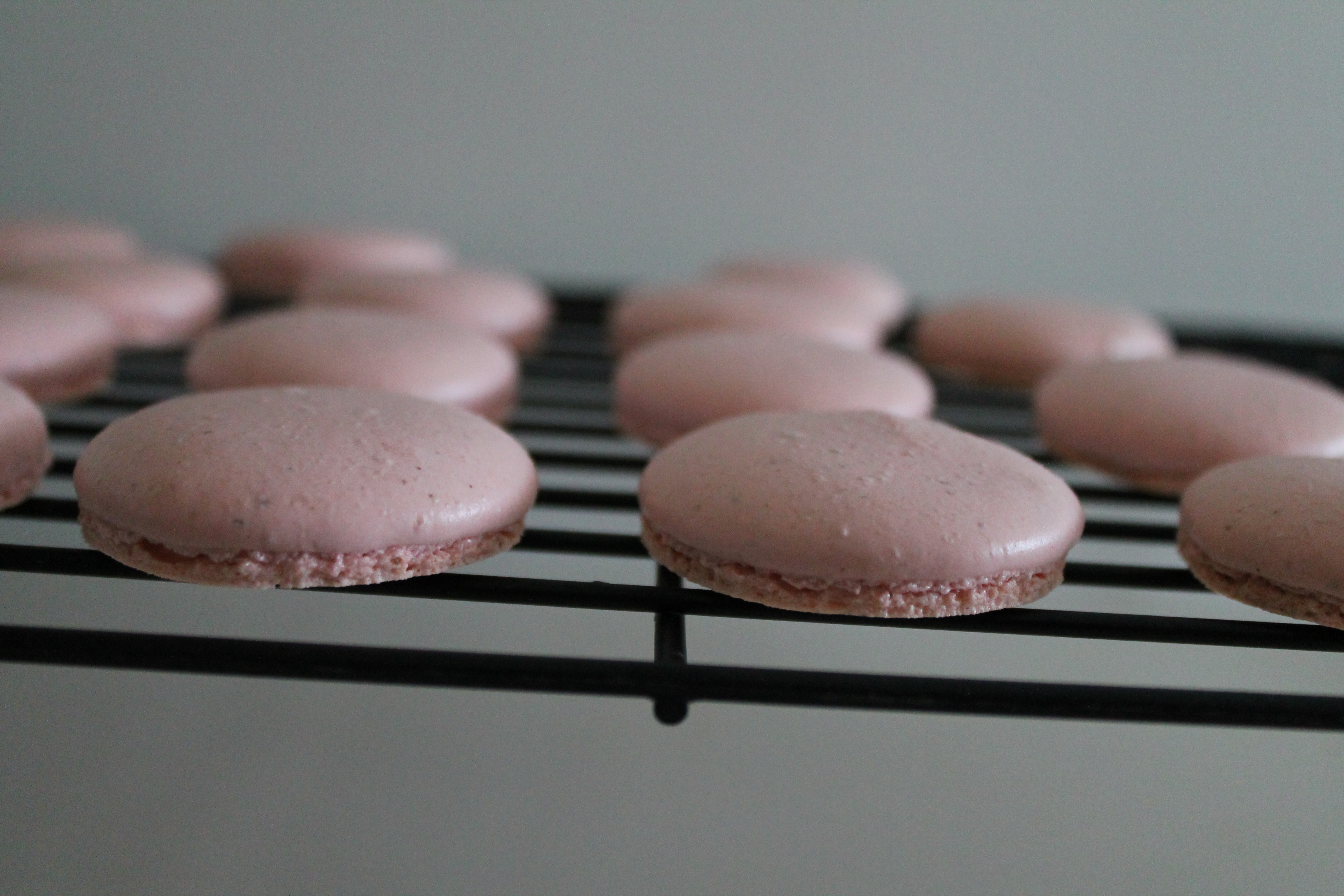 Cool for 2–3 minutes on the parchment, then remove the cookies to a cooling rack to cool completely.
Cool for 2–3 minutes on the parchment, then remove the cookies to a cooling rack to cool completely.
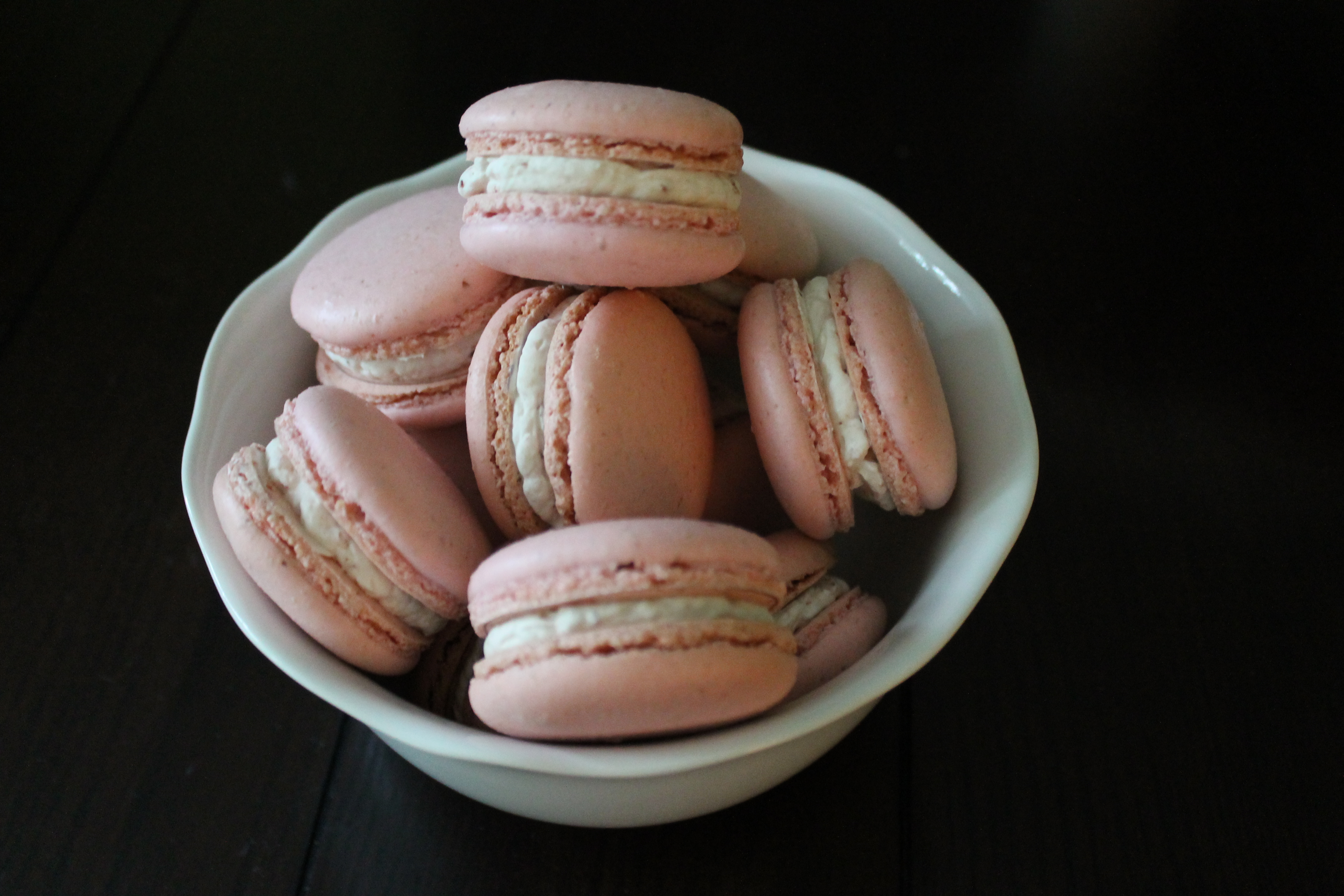 When ready, match up the cookies with an equally sized mate and fill with the frosting (or curd, jam, etc.) of your choice! I used some Strawberry Swiss Buttercream and sent these cookies into work with Dave.
When ready, match up the cookies with an equally sized mate and fill with the frosting (or curd, jam, etc.) of your choice! I used some Strawberry Swiss Buttercream and sent these cookies into work with Dave.
And remember, macarons get more flavorful with age! Resist temptation; eat them the day after you make them.
I’ve made these macarons several times, and this is the recipe I will always trust for the future. I will say that although the texture of these macarons is always perfect, chewy with a crisp exterior, I am still struggling with my oven somewhat: sometimes my meringue rises too quickly in the oven and the shells crack on top. Still delicious, but decidedly ugly. (And once, I went a little crazy and tried to smooth the tops of the piped meringue with a wet fingertip—very bad plan.) If you have any trouble with this recipe, I suggest you take a look at a these useful troubleshooting tips.
French Macarons, Italian Method
from Bouchon Bakery via Annie’s Eats
makes about 35 2″ sandwich cookies
Ingredients:
212 grams almond meal
212 grams confectioner’s sugar
82 plus 90 grams egg whites, room temperature
236 grams sugar, plus a pinch
158 grams water
filling of choice (buttercream, ganache, curd, jam)
Directions:
Preheat the oven to 350° and place a rack in the middle of the oven. Draw piping templates on parchment paper by tracing 2″ circles about 1½″ apart in a grid. Line baking sheets with the parchment paper, drawn side down.
In a large bowl, combine the almond meal and confectioner’s sugar. Stir together and break up any clumps.
Make a well in the center of the dry ingredients and pour in 82 grams of the egg whites. Stir the egg whites into the dry ingredients until evenly mixed. The mixture will be thick and paste-like.
Combine the sugar and water for the syrup in a small saucepan over medium-high heat with a candy thermometer clipped to the side. When the sugar syrup temperature is around 200°, combine the 90 gram portion of egg whites with a pinch of sugar in a mixer bowl. Whip the whites on medium-high speed until they form soft peaks. If soft peaks are achieved before the syrup reaches the target temperature, reduce the speed to low to keep the whites moving.
Once the syrup reaches 248°, immediately remove it from the heat. Set the mixer speed to medium and pour the syrup down the side of the bowl in a slow drizzle until fully incorporated. Increase the mixer speed to medium-high and whip the meringue until stiff, glossy peaks form. Add food coloring (please use gel or powder food coloring, not liquid), if desired.
Add one third of the meringue mixture to the bowl with the almond mixture. Fold in gently until the mixture is smooth. A bit at a time, gently fold in the remaining meringue until the batter is smooth and runs in thick ribbons off of the spatula. It may not be necessary to add all of the meringue, but expect to use most of it.
Add the batter to a pastry bag fitted with a plain round tip with about a ½-inch opening. Hold the bag perpendicular to the baking sheet, about ½″ above the surface of the pan. Steadily pipe rounds according to the drawn template, about 2″ wide. The batter may create small peaks immediately after piping, but if it is the correct texture these will smooth themselves away after a minute or so. If the batter is too stiff, the peaks will remain and the tops of the shells may not be totally smooth. If the batter is too thin, the rounds will spread further.
Slam the cookie sheet with the piped shells against the counter top a few times to release any large air bubbles.
Transfer the baking sheet to the oven and immediately reduce the temperature to 325°. Bake for 9-12 minutes, until the tops are smooth and set and “feet” have formed around the bottom. Let the shells cool just briefly on the baking sheet, maybe 5 minutes or so, and then peel away from the parchment. They should come away easily and fully intact. Transfer to a cooling rack.
Repeat as needed with the remaining batter, replacing the parchment paper with each batch. (Bring the oven temperature back up to 350° before baking a second sheet, and proceed as before.)
Once the shells are baked and cooled, match them up in pairs by size and sandwich with the filling of your choice. Store in an airtight container.
Enjoy!
- One year ago: Ginger Scones
- Two years ago: Brown Sugar Shortbread

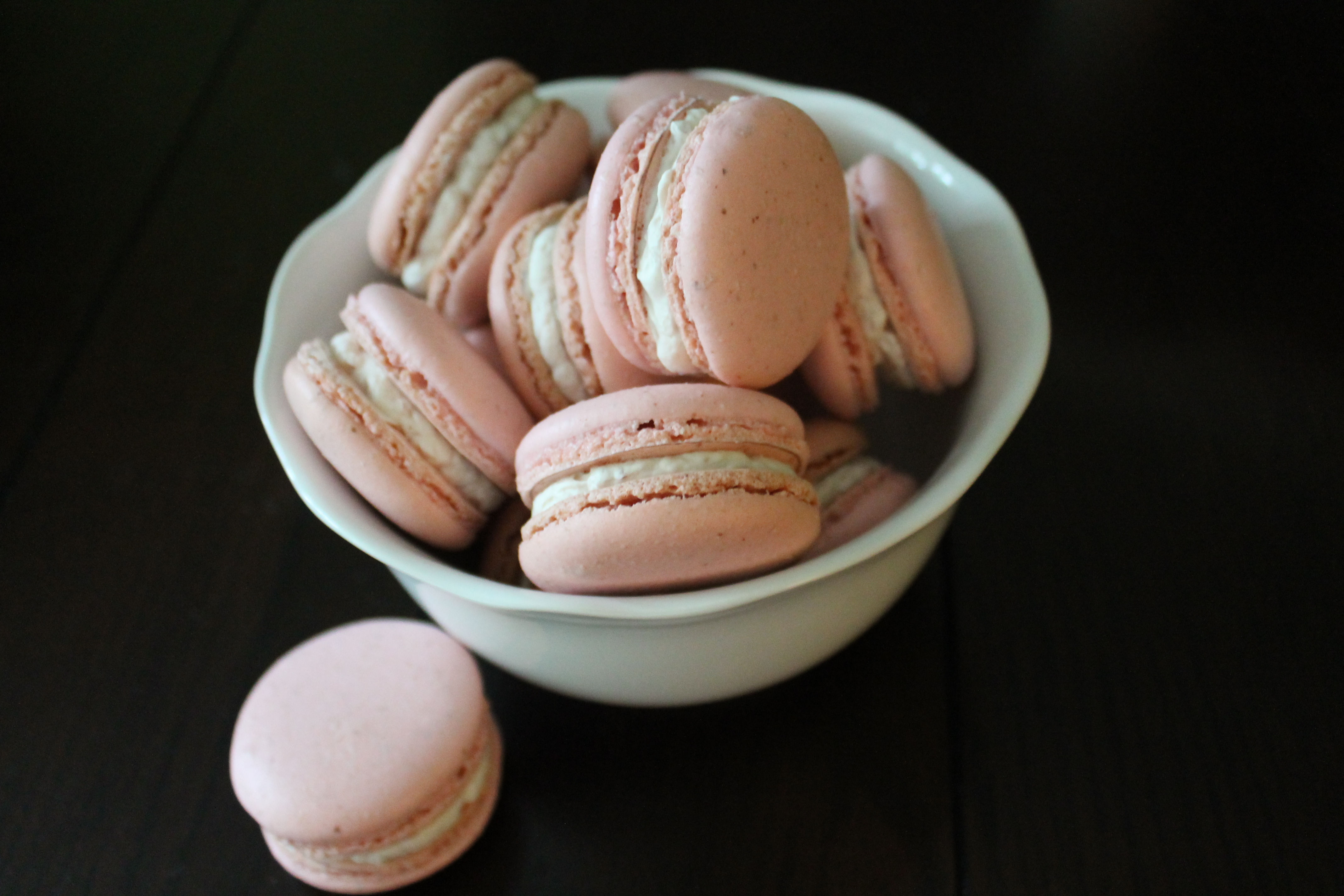
18 comments to “French Macarons, Italian Method”
Sarah - August 3, 2013
Oh my gosh, I am so impressed! I would never be able to be that precise. I do not have the heart of a baker – must be why I like galettes so much!
The Novice Gardener - August 7, 2013
I, too, had to go thru several batches of failed macarons. The good thing is, even the mistakes were delicious. Congratulations on conquering the macarons. They look perfect!
Melissa - August 7, 2013
Thanks!
a French girl "cuisine" - August 25, 2013
I love your recipe. The pictures are also really beautiful. I have also baked macaron last week if you want to have a look at my blog post.
http://frenchgirlcuisine.com/2013/08/21/french-macaron-cherry-flavour/
Isaac - October 7, 2013
Just a question about the whipping of the egg whites and egg whites in the almond mix.
Can i leave out the eggwhites in the almond mix? And is the correct time to put in the hot syrup in the egg whites, when the egg whites has just gottten foamy and you can turn the bowl upside down without the egg whites falling down? Is that the correct time? And I read 10-15 after you mix the syrup in, you need to whip it. Can I overwhip the mixture? My first time was a DISASTER, prob. because I used 20% less conf. sugar, and the worst part the egg whites either was incorporated too fast or too much, or wasnt whipped correctly.
Is the amount of sugar in either the Syrup or almond mix of any real importance(I guess it has a big impact on the macarons correct shape and size), or can i reduce it? And can i leave out the eggwhites in the almond mix? Im worried about the batter getting too wet.
It seems SO easy, but can go SO wrong.
Melissa - October 7, 2013
Hey Isaac,
So I think the thing to remember is that baking is chemistry, and if you leave out any ingredients or reduce the amount of something, it will make a chemical difference in the end product. I was skeptical, too, about adding egg whites into the almond mixture, because that’s so not the way I had learned to make macarons in the past. But I promise, the recipe will work and the batter will not be too wet! The almonds and egg whites will form a thick paste, which will just make it easier to incorporate the meringue.
It sounds to me like things may have gone wrong for you in the meringue. The one and only time this recipe didn’t work for me was when I wasn’t careful with my meringue and it became a soupy mess instead of a sweet, fluffy dream. You need to use the full amount of sugar in the syrup, and you need to be ready to use the syrup ASAP, meaning that your egg whites must already be whipped until they are stiff and foamy, but not clumpy or breaking. If there is any egg white at all unblended at the bottom of the bowl, your meringue will not whip up right. The instant your candy thermometer reads 248, you need to whip the syrup into the egg whites. Don’t wait to whip! You should be doing a sloooooow trickle of syrup into the egg whites while your mixer is whizzing on high speed. The meringue should never look soupy at all, but it should consistently get stiffer and more and more opaque as you drizzle the syrup in. I don’t think you can overwhip at this point, but if you drizzle the syrup in too fast or don’t have your mixer on high enough speed, you may have problems.
Hope that helps! Feel free to hit me back if you still have questions!
Isaac - October 7, 2013
I meant whipping it for 10-15 minutes not letting it rest for 10-15 mins lol.
Its good to know I cant overwhip after the syrup has been putting in, so that I dont have to worry about whipping it too long I have seen a dozen of macaron videos, and still im not 100% when to put in the hot syrup, I wish I had somebody to show me. I have seen it plenty of times in videos, but the eggwhite texture is something that cant be told/shown 100% correctly. I guess I´ll just have to take a chance, and put it in when the eggwhites seems to be getting to the so called soft stage. Or soft peaks as you call it. Im pretty sure when that stage is reached.
I have to experiment it seems, making a little amount with eggwhites in the almond mix and with semiwhipped(whipped but only for 6-7 minutes or so before the syrup stage) and without eggwhites in the almond mix and whipped for 10-12 mins and so on. If it keeps failing ill just have to try the foolproof french method without hot syrup. Its prob just a problem with the almondmix getting too wet/soggy, and the eggwhites not reaching full marshmallow texture.
Can you come to Denmark to teach me how to do it (-_-)
Thnx for the help. .
Melissa - October 31, 2013
Oh my, Isaac, sorry for not responding for so long!! Sometimes the kiddo distracts me and, well, out of sight, out of mind!
My egg whites who up pretty quickly in my stand mixer. I think soft peak stage is a little ambiguous, too, but aim for firm enough to stay put in the bowl a few seconds if you flip it quickly upside down, and not so firm that they start cracking or clumping.
One other thing that may present a challenge is the altitude and humidity where you are. I have no idea how they compare to the DC area (and if I could afford to come to Denmark and bake with you, I would love the adventure!) but I know from baking once in France that the atmosphere is very different. With macarons, especially, that can make a huge difference in the end result!
Personally, I have never quite had success with the French method, which is why the Italian method excited be so much.
I hope you are able to make fantastic macarons, whichever method you choose!
Dolly - February 9, 2014
Really nice publish. I just stumbled on your weblog and preferred to say
that I have really relished surfing about your website posts.
In any situation I’ll be subscribing to your feed and I hope you generate yet again pretty quickly!
best table saw - April 7, 2014
We absolutely love your blog and find many of your post’s to be just what I’m looking
for. Would you offer guest writers to write content in your case?
I wouldn’t mind composing a post or elaborating on a few of the subjects you write about
here. Again, awesome website!
Melissa - April 7, 2014
Hey, thanks for the vote of confidence! At this time, I do not feature guest posts, but if you have a recipe you want me to try out, let me know and I’ll see what I can do!
Winterrabbit - March 7, 2015
Reblogged this on Reblog it and commented:
A nice recipe on macaroons 😀
Jen - June 8, 2015
So it doesn’t look like you let your macarons rest/dry before going in the oven, is that correct?
Melissa - June 8, 2015
That’s correct! This method didn’t require any resting time. Happy baking!
Zarmeena - January 13, 2016
Can i half your ingredients without messing the recipe up?
Melissa - January 13, 2016
As long as you stick to the exact gram measurements when you halve, and make sure you use a candy thermometer when cooking the meringue, it should work fine! You might need to use a hand mixer instead of a stand mixer to account for the smaller volume of egg whites.
Zarmeena - January 13, 2016
Sounds good. After 2 weeks of obsessively reading about macarons, today’s the day! Fingers crossed.
Melissa - January 13, 2016
Good luck! You can do it!